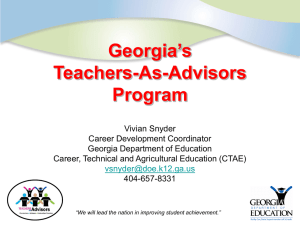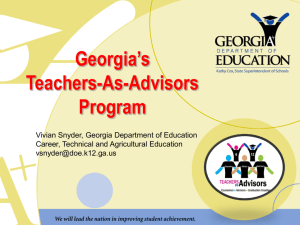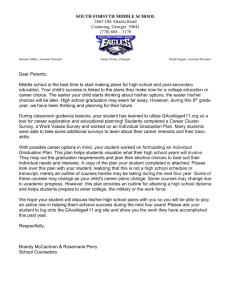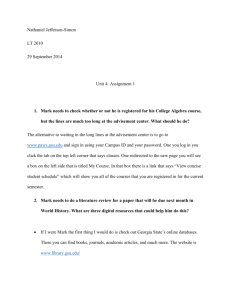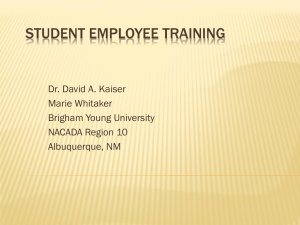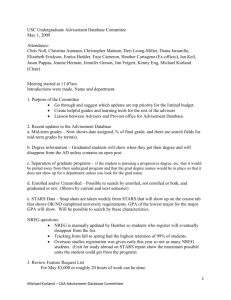BRIDGE - GADOE Georgia Department of Education
advertisement
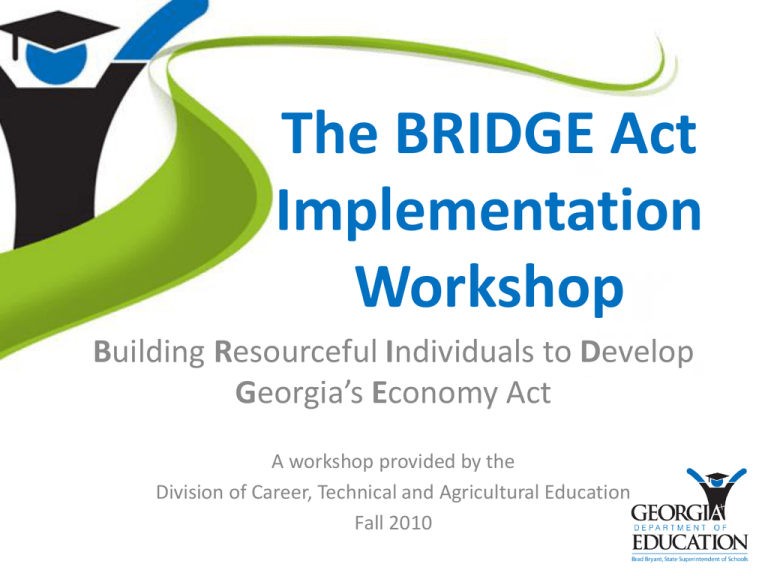
The BRIDGE Act Implementation Workshop Building Resourceful Individuals to Develop Georgia’s Economy Act A workshop provided by the Division of Career, Technical and Agricultural Education Fall 2010 Workshop Agenda Gain awareness and understanding of BRIDGE Act Goals Expectations Determine status of your system and school practices Prioritize actions for implementation Establish a structure for planning and managing the implementation of the BRIDGE Act in your school Please try to limit phone calls to break time Strategic Goal 1 • To increase the graduation rate, decrease the drop- out rate, and increase postsecondary enrollment rate • Strategy: To develop an effective comprehensive advisement system focusing on postsecondary options and career planning. • Initiative: GAcollege411 (currently writing a proposal to include TAA as an additional initiative) BRIDGE BILL Grades 6-12 Mandated ADVISEMENT & COUNSELING The BRIDGE Bill HB 400 Building Resourceful Individuals to Develop Georgia’s Economy Act Applicability • 20-2-326 • 20-2-327b • 20-2-327a • 20-2-328 • 20-2-329 Provides common definitions Articulation agreements and student advisement Postsecondary Placement re: GHSGT Competitive grant subject to appropriations High schools that receive a grant develop POS, TAA, and elements • Articulation-means agreement between a high school and a postsecondary institution regarding the awarding of both secondary and postsecondary credit for a dual enrollment course Essential Requirements handout • Student performance at the advanced proficiency/honors level on any assessments required for purposes of high school graduation shall be recognized as: Meeting postsecondary placement test requirements, and • Qualifying students to enroll in credit-bearing postsecondary course work in accordance with policies and requirements established by the State Board of Education, the Board of Regents of the University System of Georgia, and the State Board of Technical and Adult Education Secondary and Postsecondary Credit • Shall be awarded immediately upon successful completion of any articulated or dual enrollment course in accordance with policies and requirements established by the State Board of Education, the Board of Regents of the University System of Georgia, and the State Board of Technical and Adult Education Beginning 2010-2011 School Year • Students in the sixth, seventh, and eighth grades shall be provided counseling, advisement, career awareness, career interest inventories, and information to assist them in evaluating their academic skills and career interests. The Individual Graduation Plan • Before the end of the second semester of the eighth grade, students shall develop an individual graduation plan in consultation with their parents, guardians, or individuals appointed by the parents or guardians to serve as their designee. High School Guidance • High school students shall be provided guidance, advisement, and counseling annually that will enable them to successfully complete their individual graduation plans, preparing them for a seamless transition to postsecondary study, further training, or employment. Components of the Individual Graduation Plan • Includes rigorous academic core subjects and focused work in: • Mathematics and science or • Humanities, fine arts, and foreign language or • Sequenced career pathway coursework Other Components • Incorporate provisions of IEP where applicable • Align educational and broad career goals and a student’s course of study • Be based on the student's selected academic and career focus area as approved by the student’s parent or guardian • Include experience based, career oriented learning experiences which may include, but not be limited to, internships, apprenticeships, mentoring, co-op education, and service learning Individual Graduation Plan Should: • Include opportunities for postsecondary studies through articulation, dual enrollment and joint enrollment • Be flexible to allow change in the course of study but be sufficiently structured to meet graduation requirements and qualify the student for admission to postsecondary education • Be approved by the student and the student's parent or guardian with guidance from the student's counselor or teacher advisor BRIDGE Implications for LEAs: • Mandates 6-12 system of advisement for ALL students through systematic, comprehensive and developmental advisement • Mandates 6-8 educational and career planning including counseling, advisement, career awareness, career interest inventories and information to result in an individual graduation plan • Mandates continued advisement 9-12 17 •Building our BRIDGE to Georgia’s workforce Debrief and Group Work • Split into school or system teams • Who has the been in education longest? • Identify current components already in place within system that can be used as part of BRIDGE • What are the current obstacles/barriers you see in implementing BRIDGE within your system? (Funds, Time, Personnel) A Changing Supersystem The supersystem in which our educational system operates is changing at an exponential rate. The Supersystem … Then & Now Industrial Era Information Era Standardization Bureaucratic organization Centralized control Adversarial relationships Autocratic decision making Compliance Conformity One-way communications Compartmentalization Parts oriented CEO or boss as “king” Customization Team-based organization Autonomy with accountability Cooperative relationships Shared decision making Initiative Diversity Networking Holism Process oriented Customer as “king” Reigeluth, 1989 The Changing U.S. Workforce Unskilled 60% Skilled Unskilled 20% 15% Professional 20% 1950 National Summit on 21st Century Skills for 21st Century Jobs Professional 20% Skilled 65% 2007 What Does This All Mean? When the supersystem changes, the subsystems must change in equally significant ways to survive, or risk becoming obsolete. We can and must do more. Spirit of the Perkins IV Leading CTE into the 21st century • Global competition • Program improvement • Ensuring modern, durable and rigorous CTE programs Purposes of the Act • Develop challenging academic and technical standards and related challenging, integrated instruction • Promote partnerships (education, workforce boards, business, industry, etc.) • Connect education, workforce development and economic development A Focus on the Economy and Transitions • Focus on high skill, high wage, high demand and relate to regional economy • Increase transition from 2 to 4 year college • A focus on articulation Programs of Study Supports Perkins’ Goals Important Definitions • Career cluster – organizer of knowledge and skills needed by a broad industry for the purpose of organizing educational programs and curricula • Career pathway – organizer of knowledge and skills statements shared by professions • Program of study – comprehensive, structured approach for delivering academic and career and technical education to prepare students for postsecondary education and career success Perkins IV: POS Definition • Incorporate and align secondary and postsecondary education • Include academic & CTE content in a coordinated, non-duplicative progression of courses • May include the opportunity for secondary students to acquire postsecondary credits • Lead to an industry-recognized credential or certificate at the postsecondary level, or an associate or baccalaureate degree Programs of Study Framework • Jointly developed by OVAE, states, and several associations • Designed to expand the expectations of and define what a high quality POS should look like POS Framework Insights College and Career Readiness Standards • Ex: Common Core Standards (NGA & CCSSO) • Will likely be reflected in ESEA reauthorization • Standards are key to portability of credits/credentials Course Sequences • Ex: NE and MD are working at the lesson plan level • Begin broad and over time move to occupation specific instruction • Flexibility and choice for students is key to success POS Framework Insights Credit Transfer Agreements • Ex: Running start program in WA • Transcripted credit is gaining momentum as a solution • Must commit to a seamless, student-centered system Guidance / Counseling & Academic Advisement • Ex: Missouri Center for Career Education (MCCE) / Nebraska DOE • The National Career Development Guidelines provide a starting place POS Framework Insights Teaching and Learning Strategies • Ex: Loving High School and Mosquero High School – Featured in a Microsoft/NASDCTEc Implementation Guides • Teachers don’t have to be an expert on everything • Need to provide access to high quality resources Technical Skill Assessments • Important! Assessments must be meaningful • Performance-based assessments and portfolios, in conjunction with traditional assessments are gaining momentum in ESEA reauthorization discussions Resources • OVAE Program of Study Framework Document: http://cte.ed.gov/file/POS_Framework_Unpacking_1-20-10.pdf • Career Clusters: A Plan of Education for a Global Economy http://www.careertech.org/uploaded_files/Career_Cluster_Research_Brief __-_final.pdf • Implementing Programs of Study: What, Why and How? http://www.careertech.org/uploaded_files/Final1.pdf • NASDCTEc Webinar Series on Programs of Study http://www.careertech.org/webinars • Career Clusters Website: www.careerclusters.org • Sample Plans of Study: http://www.careerclusters.org/resources/web/pos.cfm Program of Study….Individual Graduation Plan….Plan of Study….. Are there Differences in the Terms? Not Really…. All three require that students plan for high school success, as well as plan for success after high school Perkins Act –Program of Study terminology BRIDGE Act –Individual Graduation Plan terminology GaCollege411 website –Plan of Study terminology Brad Bryant, State Superintendent of Schools “We will lead the nation in improving student achievement.” 35 GAcollege411 POS screenshot Georgia’s 11 Program Concentrations • Represent a grouping of occupations according to common knowledge and skills for the purpose of organizing educational programs and curricula Agriculture Architecture, Construction, Communications & Transportation Arts & Humanities Business & Computer Science Culinary Arts Education Engineering & Technology Family & Consumer Sciences Healthcare Science Government & Public Safety Marketing, Sales & Services Career Pathway • Is a coherent, articulated sequence of rigorous academic and career/technical courses, usually beginning in the 9th grade and leading to a diploma, associate degree, baccalaureate degree and beyond. Nursing PATHWAY/Curriculum Emergency Services PATHWAY/Curriculum Medical Services PATHWAY/Curriculum Health Informatics PATHWAY/Curriculum Healthcare Science CONCENTRATION Biotechnical Research & Development PATHWAY/Curriculum Diagnostic Services PATHWAY/Curriculum Physical Medicine PATHWAY/Curriculum Personal Care Services-Cosmetology PATHWAY/Curriculum 25.52100 Introduction to Health Science Therapeutic Services Nursing 25.52200 Application to Therapeutic Services 25.56100 Nursing Essentials Advisement/Bridge Act (HB 400 May, 2010) Advisement is a vital part of education and career planning for ALL students. In May the Governor signed the Bridge Bill to mandate advisement in grades 6-12. Three methods of delivery to result in an individual graduation plan: Georgia’s Counselor-Supported 6-12 Teachers-As-Advisor (TAA) Program Model GeorgiaStandards.org for Middle Schools • 32.02100 Career Awareness • 32.02200 Career Discovery • 32.02300 Career Management • ELA CAPSTONE Project Local middle and high school counselor’s program provides comprehensive and developmental counseling and advisement to all students in grades 6-12 Effective advisement is measured by the utilization of GAcollege411 in all middle and high schools Georgia’s Teachers-As-Advisors Program Vivian Snyder Career Development Coordinator Georgia Department of Education Career, Technical and Agricultural Education (CTAE) vsnyder@doe.k12.ga.us 404-657-8331 It’s a question of: How many opportunities do ALL Georgia students have to explore the world of work? To understand the connection between school work and their future career? To assess their individual interests and aptitudes? To assess their work values and preferences? To assess their individual learning, collaboration, and problemsolving styles? To develop a plan of action to reach their educational and career goals? What is TAA? A systemic, systematic method of delivery wherein an entire student population (grades 6-12) is assigned, in small groups, to a trained, caring adult advisor who both advocates for his or her advisees and facilitates sessions focused on: 1. Career Management: Awareness, Exploration, and Planning 2. Academic Achievement, Educational Attainment and Lifelong Learning: Academic Development 3. Life Skills: Personal and Social Development The TAA 10-Step Model 1. Establishing Need and Gaining Awareness of Data 2. The Educational and Career Planning Process 3. Articulating a Statement of Purpose 4. Strategic Planning for Parent/Family Involvement 5. Achieving Consensus on Organization and Logistics 6. Designing Framework-Based Content for Delivery 7. Understanding and Fully Utilizing Assessment Results 8. Determining the Level of Leader Involvement and Support 9. Professional Learning and Ongoing Support 10. Assessing the Effectiveness of a TAA Program Training Goals • Gain awareness of the 10-Step Model for creating, implementing, enhancing, and/or evaluating a systemic and systematic TAA program that serves ALL students within a local educational agency (LEA) in grades 6-12 • Create a vision and purpose for advisement that is based on theory, research, and field expertise Training Goals • Address issues of school processes and structures that support and/or diminish the effectiveness of TAA • Explore the Georgia TAA framework and plan activities to use during advisement sessions • Investigate the utilization of assessment mechanisms • Learn how to build capacity and create conditions for TAA long-term sustainability State TAA Training Tools • Video modules that will demonstrate the process for development and implementation • Accompanying, coordinated materials and resources to assist the advisement focus team • Online repository of lessons through GeorgiaStandards.Org (GSO) • Assessment resources/GAcollege411.org GSO: Online Resources Link GSO: Online Resources Link GSO: Online Resources Link GSO: Online Resources Link GSO: Online Resources Link Georgia Teachers-As-Advisors Framework Establishing Need and Gaining Awareness of Data Facing the Brutal Facts • • • • • • Georgia high school graduation rate? Under 80% 9th grade retention rate? Too high, overrepresentation of specific groups of students Postsecondary matriculation? Poor, sometimes less than 20% Labor market needs? Skills shortage, labor shortage A 2001 study by the National Association of Manufacturers revealed that 78% of work force representatives believe public schools are failing to prepare students for the workplace. This represents little change from similar 1991 and 1997 surveys administered by the agency, despite a decade of various education movements. Parental involvement? Very little, low level of authenticity Anonymity of students? Yes, we have students we don’t really know. Education and Training Pays Georgia Workforce 2016 Beyond the Horizon. Workforce Information & Analysis Division, p 28. Face the facts! Ask yourselves… • What are the high-skill, high-demand, high-wage jobs identified for your county or region by the Georgia Department of Labor (DOL), the Governor’s Office of Workforce Development, etc.? • What are the programs of study offered at your local high schools? • Are the two aligned? Will they lead your students to high-skill, high-demand, and high-wage careers? An Essential Difference Counseling Advisement The help that some students need to overcome personal and social problems that interfere with learning. The help that ALL students need from parents, teachers, counselors and others to assist with educational and career development and planning. Resources for Establishing Need and Gaining Awareness of Data • Georgia Department of Labor/Georgia Labor Market Explorer http://www.dol.state.ga.us http://explorer.dol.state.ga.us • Occupational Supply and Demand System http://test.occsupplydemand.net/OSD_Main.aspx • One Georgia Authority http://www.onegeorgia.org/coi.html • Partnership for 21st Century Skills http://www.21stcenturyskills.org/ The Educational and Career Planning Process Basic Assumptions • ALL educators are career developers. “Teachers make all professions possible” Annie Belott • ALL students are expected to work, therefore, ALL students need career development. “The future of work is ‘learning a living.’ ” Marshall McLuhan • Parents can be the greatest influence in a student’s career decision-making process. Therefore, parents need information also. Who Am I? GACollege411, including • Interest Profiler • Career Cluster Survey • Work Values Sorter • Transferable Skills • Career Keys • Basic Skills PSAT Armed Services Vocational Aptitude Battery(ASVAB) Where Am I Going? • Georgia Teachers-As-Advisors Framework and Activities • O*NET, Careerclusters.org; OOH; Career Voyages (USDOL and USDOE) • Career Centers - Knowledge, Resources, Materials, and Tools • Labor Market Information – DOL/Georgia Explorer • Work-Based Learning (MS and HS) • GACollege411 – Career Planning • Classroom Activities How Am I Going To Get There? • Electronic Portfolio System GAcollege411.com www.GAcollege411.org • Peach State Pathways http://www.gadoe.org/ci_cta.aspx?Page Req=CICTAPlanningNew Articulating a Statement of Purpose Program Purpose: Specific purposes your advisory program be designed to meet: Program Purpose Priority Value - Essential, nonnegotiable - Important, but negotiable - Experimental and negotiable Addresses students’ needs in what ways? Reflects the needs of the community in what ways? - All students? - Subgroups? Finally, write a statement of purpose and create a framework for your advisory program. Refer to other parts of this document, GADOE resources, Breaking Ranks II, Breaking Ranks in the Middle and other potential resources. “Georgia will lead the nation in student achievement.” K. Cox Jefferson County School System Teachers-As-Advisors Statement of Purpose The mission of the Jefferson County School System Advisor-Advisee Program is to ensure high levels of student achievement through the following: • Providing a caring, trained adult advocate • Establishing regular communication and an effective link between home and school • Advising students about academic decisions and monitoring academic achievement • Creating, facilitating, and guiding movement toward a career concentration so that each child will be postsecondary ready • Facilitating seamless academic and social transitions across grades and schools for students and their families Strategic Planning for Parent/Family Involvement Strategic Planning for Parent/Family Involvement • How do we create parent and family involvement that is systemic, systematic, and authentic? • What are the “value-added” elements of parent and family involvement in the Teachers-AsAdvisors process? Strategic Planning for Parent/Family Involvement Basic indicators for the relationship between advisor and family: • Friendly, helpful environment • Genuine concern • Communication, communication, communication • Viewing parents as partners • At the least an annual review of student progress in the spring of each year Achieving Consensus on Organization and Logistics People and Size • How many advisees will each advisor have? • Which adults in the school will serve as advisors? What characteristics should they possess? • If some teachers do not serve as advisors, what supportive roles can they take on? Will any advisories be co-facilitated? • By what criteria will the students be divided into advisory groups? • By what criteria will individual students be paired with advisors? • Will advisors and advisees be looped (paired for their tenure in the building)? What, if any, exceptions would there be to that rule? • What will be the specific roles and responsibilities of advisors? • How will parents be included and involved in the advisory process? • How or will business and community volunteers be included and involved in the advisory process? Effective Practices: People & Size • Consider one advisor to 12-18 student advisees (average) • Come to consensus who will serve as advisors? Certified staff only? • Co-facilitate advisories in working with students with disabilities (create two small advisee groups and pair two advisors (one reg. ed and one spec. ed); this allows for inclusion of SWDs, with the option of utilizing advisory time to, occasionally, review IEP progress). • Match advisors-advisees based on interests, advisor-strength/ student need(s), personalities, etc. – anything but the “alphabet” method! • “Loop” advisors-advisees for a student’s duration in the building- The longitudinal relationship and the knowledge it yields are the powers of TAA! • Utilize a rubric to define and assess roles and responsibilities of advisors. • Connect with parents through on-going communication, establishing the advisor as the central contact point at the school, and increased conferencing. • Business and community partners are an invaluable resource in advisement, especially in the career and workforce development components. Time and Space • How often will advisement sessions meet (daily, weekly, monthly, etc.)? • How long will advisement sessions be (brief check-ins, longer activity periods)? • Will there be time for individual meetings as well as group meetings? • How will this time fit into the master schedule? • Where will advisories meet? • How will advisories be able to personalize their space? • Will each advisory have its own space? Effective Practices: Time & Space • Hold a minimum of two advisory sessions per month; however, more frequent meetings of a shorter duration are equally as effective. • Look for informal ways to connect with advisee between advisory sessions (Ex.-look for a face-to-face connection with each advisee 2-3 times per week…perhaps simply saying “hello” in the hall or cafeteria). • Consider a blend of brief check-ins, longer activity periods; ideally, both types of sessions are needed. • Allow for meetings with individual students, as well as the regular small-group, advisory meetings. • Advisement is easily scheduled in middle and high schools. Consider the creation of a scheduled period that allows for extra-help and/or enrichment; advisement is an appropriate, additional use of that time. • Flexibility is a key element when considering meeting space for advisory groups… students just need a comfortable place! Student Involvement/Ownership • What role will students take in creating/overseeing the advisory program? • How can advisement in grades 6-12 serve as a vehicle for raising graduation rates? • How can advisement in grades 6-12 serve as a vehicle for raising student achievement? • How can advisement in grades 6-12 serve as a vehicle to facilitate more students pursuing postsecondary study? • How can students in the upper-grade advisements mentor students in the lower-grade advisories? Effective Practices: Student Involvement/Ownership • Create a TAA advisory committee made up of students to gain students’ perspectives on the total advisement program and its processes. • Give students (grades 6-12) a voice in considering the following: • – How can advisories serve as a vehicle for raising graduation rates? – How can advisories serve as a vehicle for raising the rigor of core academic studies and student achievement? – How can advisories serve as a vehicle for leading students to a focused area of study in high school? – How can advisories serve as a vehicle to facilitate more students pursuing postsecondary credit opportunities (during high school) and postsecondary study (after graduation)? Create structures for students in the upper-grade advisories to mentor students in the lower-grade advisories. Designing Framework-Based Content for Students Designing Framework-Based Content for Students Use the Georgia TAA Framework to gather materials and develop TAA sessions/activities • TAA Framework can be found at GeorgiaStandards.Org under “Resources” at https://www.georgiastandards.org/Resources/Pages/Tools /Teachers-as-Advisors.aspx TAA 6-8 Scope & Sequence TAA 9-12 Scope & Sequence Understanding and Fully Utilizing Assessment Results Understanding and Fully Utilizing Assessment Results Draw from multiple assessment resources to gain a comprehensive look at each individual student (strengths, interests, aptitude, work values, and preferences). • State Assessments (CRCT, EOCT, GHSGT, etc.) • PSAT, SAT, etc. • GAcollege411 six Career-related Assessments • Armed Services Vocational Aptitude Battery (ASVAB) • Other interest, aptitude, and work-values and preferences assessments Determining the Level of Leader Involvement and Support Determining the Level of Leader Involvement and Support Who will champion Teachers-As-Advisors in your district or school? Responsibilities • Principal responsibilities • Advisor responsibilities • Counselor responsibilities • Advisee responsibilities Barriers and challenges and how to address them Professional Learning and Continued Support Professional Learning and Continued Support Develop a professional learning plan to include: • Informational sessions • Skill building sessions • Continued support − Regular feedback - What works! − Incentives - Help me! − Results data - Is this work paying off? Professional Learning and Continued Support • How do we create regularly scheduled time for advisors to meet with students (coordination with the academic calendar and time for training, curriculum development, sharing successes)? • In what types of configurations can advisors meet for training and support (clusters, teams, full faculty, pairs)? • How will we identify the types of training and support advisors need (academic advising, how to communicate with parents, listening skills, knowing when to refer advisees to others, etc.)? • How will the initial training be conducted and by whom? • What resources will advisors need? Will these resources be readily available? • What ongoing support will be provided after initial training? • How will advisors be observed and assessed? Effective Practices: Professional Learning and Continued Support • Because advisement is best implemented at the district level, form a district-level TAA focus team that is made up of school-level focus teams. A school-level focus team should be made up of (5-7 members): – the principal (or his/her administrative designee) – counselor(s) and/or graduation coach(es) – teachers who are skilled at building relationships with students – teachers who are knowledgeable of career development – teachers who may be skeptical of the value of advisement • Building leaders must protect time scheduled for advisement. • Consider holding sessions for TAA training and support during the school day (planning periods) and forming additional support structures (clusters, teams, pairs) for teacher-advisors. • Identify the types of training, resources, and support advisors need through information gathered from teacher-advisor surveys, student surveys, postadvisement reflections, and observation of advisory sessions. Assessing TAA Program Effectiveness Assessing the Effectiveness of a Teachers-As-Advisors Program • Data-driven outcomes (programmatic measures, advisor effectiveness, student satisfaction, parent satisfaction, etc.) - What kinds of data will you collect? - How will you gather data to measure outcomes? Graduation; retention; behavioral referrals; # of students taking higher level courses; pathway selection; utilization of GACollege411;survey students, staff, and parents • Rubrics − How will you develop rubrics and hold each participant in the process accountable? Evaluating Your Teachers-As-Advisor Program ADVANCED PROFICIENT BASIC DEVELOPING (Majority of criteria checked in each section) (Minimum of 3 criteria checked in each section) (Minimum of 2 criteria checked in each section) (Must have at least 1 criterion checked in each section) 56-66 Points 41-55 Points 26 – 40 Points 11- 25 Points NOT YET ESTABLISHED (No criteria checked in one or more sections) 0-10 Points Advanced Your TAA program is well established. Continue to review and self-evaluate after every session and make required adjustments as needed to continue to help students be successful. Proficient Your TAA program has engaged the majority of your school’s staff, students and parents. The TAA activities are varied and supportive of students’ goals. Continue to challenge yourselves to find additional ways to provide students the opportunity to develop skills they need for future success. Basic Your TAA program is meeting the standard. Continue to meet on a regular basis with your advisory committee, encourage staff participation, and seek feedback from students and parents to help make progress in what you’re doing. Developing Your TAA program is in the development stage. You most likely have been working hard to develop a program in which everyone is actively involved. You feel frustration because not everyone views it as their job to assist students in planning for their future. Continue to seek administrative support, train staff on a regular basis and seek community assistance. Not Yet Established Seek assistance because your TAA program may need improvement or you have not worked to develop and implement a TAA program. Implementing TAA • Teachers-As-Advisors is BEST implemented at the DISTRICT level by a TEAM of professionals. In a very large district, this can be done by MS-HS feeder patterns. • The district-level TAA Focus Team should be made up of its school-level focus teams. A school-level focus team should be made up of (5-7 members): − The principal (or his/her administrative designee) − Counselor(s) and/or graduation coach(es) − One or more teachers who are skilled at building relationships with students − One or more teachers who are knowledgeable of career development − One or more teachers who may be skeptical of the value of advisement and have a need to be a part of the development Training Dates • Nov 15, 2010 in Macon at Central Georgia Technical College • Nov 19, 2010 in Athens at the Clarke County BOE • Nov 30, 2010 in Blairsville at the Union County BOE • Dec 1, 2010 in Alpharetta at the North Fulton Professional Learning Center (old Milton High School) Additional information can be found on the CTAE Resource Network at www.ctaern.org in the catalog under the course number CTAERN3075 Thank you for attending! Georgia’s Teachers-As-Advisors Program Vivian Snyder Career Development Coordinator Georgia Department of Education Career, Technical and Agricultural Education (CTAE) vsnyder@doe.k12.ga.us 404-657-8331 In Your Groups • Answer the following questions • What strategies can you implement to get teacher and administrator buy- in for TAA? • If not TAA implementation, what strategy are you planning to use to meet the BRIDGE Act? What You Need To Know • Counselors regard confidentiality as essential for student trust. • School counselors are governed by the” Code of Ethical Standards for School Counselors” • The Code describes the behaviors and guidelines for practice. • The Code of Ethics recognizes that students have a right to privacy and confidentiality with certain limits. “We will lead the nation in improving student achievement.” Confidentiality • Is the counselor’s promise to respect the student’s right to privacy and will not be shared with anyone without consent. • Parents of minors have a legal right for the development of their children. • Teachers, Advisors, Mentors are not bound by confidentiality codes. “We will lead the nation in improving student achievement.” Privileged Communication • Is granted by statute and guarantees clients that a court can’t compel a counselor to disclose information discussed in confidence. • Very few school counselors have privileged communication. “We will lead the nation in improving student achievement.” Exceptions to Confidentiality • • • • • Child Abuse and Neglect Student has committed and illegal act. Student intends to commit a crime. Parent (or eligible student) waives right. Potential harm to self or others. American Student Achievement Institute “We will lead the nation in improving student achievement.” Legal Issues • Refer to accepted professional practices in the community. • Noncustodial parents have all rights regarding their children except the right to have custody of the children permanently in their homes. “We will lead the nation in improving student achievement.” Remember! • Know when and how to refer. • Know that if a student shares potential harmful information ,that information cannot be kept confidential. • Counselors have an ethical, legal, and confidential responsibility to students. • A teacher advisor does not have the same code of ethics umbrella as a school counselor. “We will lead the nation in improving student achievement.” Delivery Method • Counselor Survey • Counselor Rubric with BRIDGE Components • Student Advisement Board Rule Change to include BRIDGE Bill • New counselor email database for timely and current communication “We will lead the nation in improving student achievement.” Rubric Elements • • • • Definitions Will include ASCA content Draft to be completed by February for review Will have input from counselors “We will lead the nation in improving student achievement.” Survey • Will have BRIDGE requirements • Based on the End of Year Data Elements developed by a statewide counselor committee • Will be an on-line instrument • May require the submission of a system level school counseling plan • Completion date of early next year. “We will lead the nation in improving student achievement.” Counseling (BRIDGE) • • • • Academic Personal Career Involves both students and parents “We will lead the nation in improving student achievement.” Examples • Students who have been affected by the economy. • Homeless and transient students. • Students may have to postpone, defer or make other options. • Cultural and parental issues. • Bullying and other kinds of abuse. “We will lead the nation in improving student achievement.” What Counselors must Do! • Identify the critical student competencies that should be addressed • Identify the necessary resources for implementation • Review the student data • Develop an Action Plan • Advocate for the Counseling Program “We will lead the nation in improving student achievement.” Think About It • How does the student achievement and graduation rate data look for your school or system? • What can you do to improve a ‘College and Career Readiness Culture? • What implications does this information have on the future of your community and the lives of your students? “We will lead the nation in improving student achievement.” Power Strategies 1. 2. 3. Develop an “Early Warning System” (Advisement) Align Guidance and Counseling with “Response To Intervention (RTI)” Consistently review and assess School Counseling Program to align with legislation and school improvement. “We will lead the nation in improving student achievement.” GAPPS and BRIDGE • Strand: Student, Family, and Community Involvement • The school as a community of learning involves parents and community members as active participants. There is a consistent and growing evidence of parental involvement and volunteerism, participation in workshops and enrichment activities, and a process of two-way communication. Everyone collaborates. “We will lead the nation in improving student achievement.” GAPPS and BRIDGE • Strand: Professional Learning • Professional learning is the means by which teachers, administrators, and other school and system employees acquire, enhance and refine the knowledge, skills, and commitment necessary to create and support high levels of learning for all students. “We will lead the nation in improving student achievement.” GAPPS and BRIDGE • Strand: Leadership • The governance process through which individuals and groups influence the behavior of others so that they work collaboratively to achieve common goals and promote organizational effectiveness. “We will lead the nation in improving student achievement.” GAPPS and BRIDGE • Strand: School Culture • The norms, values, standards, and practices associated with the school as a learning community committed to ensuring student achievement and organizational productivity. “We will lead the nation in improving student achievement.” School Culture Impacts • • • • Academics Behavior Attendance School climate “We will lead the nation in improving student achievement.” Middle School Curriculum • Career Development – 6th: 32.02100 – Career Awareness – 7th: 32.02200 – Career Discovery – 8th: 32.02300 – Career Management • To teach these 9 week courses, teachers should have one of following • CTAE certification or clear certificate • School counselor certification • Career Development Endorsement Middle School Capstone Project • Partial fulfillment of BRIDGE Bill/8th Grade Advisement • Student identifies chosen career interests via inventories • Integrate career interests assessments from GAcollege411 into ELA GPS research and technical writing standards • Collaborate with ELA and CTAE teacher/CTSO advisor and counselor or Teacher-As-Advisor to complete the career interest project (demo, presentation, report, web page) • Present career interest project to parents and staff in a student-led conference in January/February during student scheduling for transition to 9th grade/high school Middle School Capstone Project Coming in Fall 2011 During the ELA unit entitled “Take this Job and LOVE It” 8th grade students will research/write and develop their career interest August Students integrate career interest assessments from GAcollege411.org into research & technical writing Students research/write a report on a career of their choice September Work with CTAE staff to complete the performance, demonstration portions of project Brad Bryant, State Superintendent of Schools “We will lead the nation in improving student achievement.” Students complete 8th Grade Project for Student Led Conference; creating Program of Study January - Apri Students enter Project in CTSO State Leadership Conference 123 A partnership to assist ALL Georgia students with “educational and career planning” •Career Cluster Survey customized to Georgia’s 11 Program Concentrations •Career information customized to Georgia’s 11 Program Concentrations and Peach State Pathways •Six career-related inventories/surveys •Extensive career exploration tools •Extensive financial aid information including scholarships •TAA program activities and other resources •Extensive college application files including other valuable “college going” resources along with a transcript portal and tracking tools •Extensive data collection tools GaDOE education and career planning tools, materials and resources located at the bottom of the homepage of GAcollege411 in the file “Middle and High School Resources” Questions/Comments Thank you We look forward to your implementation of BRIDGE
